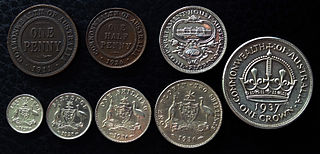

Pre-decimal Australian coins arose when the Federation of Australia gave the constitutional power to Commonwealth of Australia to mint its own coinage in 1901. The new power allowed the Commonwealth to issue legal tender rather than individually through the six former British self-governing colonies of Queensland, New South Wales, Victoria, Tasmania, South Australia, and Western Australia.
However, with the adoption of a Federal government in Australia, British coins continued to be used until 1910 when the first Australian silver coins were introduced. These new coins, which included florins, shillings, sixpences and threepences, were all minted with a portrait of Edward VII. A year later Australian pennies and half-pennies entered circulation. Unlike in New Zealand, there was no half-crown. In 1931 gold sovereigns stopped being minted in Australia. A crown or five-shilling coin was minted in 1937 and 1938.
Coinage of the Australian pound was replaced by decimalised coins of the Australian dollar on 14 February 1966. The conversion rate was A$2 = A£1.